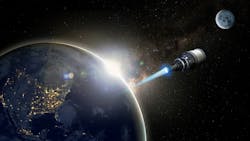Military researchers consider nuclear power for space propulsion to move spacecraft beyond Earth's orbit
ARLINGTON, Va. – The U.S. Defense Advanced Research Projects Agency (DARPA) is awarding three contracts to design a nuclear-powered spacecraft by 2025. Mic.com reports. Continue reading original article
The Military & Aerospace Electronics take:
27 April 2021 -- So why is the U.S. military set on using nuclear power to push its rockets into space? It's largely about the ability to move smoother and faster in the space between Earth and the moon.
Today's spacecraft rely either on electric or chemical propulsion systems, which significantly limits maneuverability once they exit the Earth's atmosphere. Nuclear power could solve these issues, by providing a high thrust-to-weight ratio.
This development would be essential for future ambitious space propulsion, including exploring distant planets. "Nuclear thermal propulsion is a transformative technology that will dramatically change the way spacecraft will operate, increasing agility and allowing more efficient travel to Mars and beyond in far less time than conventional propulsion systems," says Bill Pratt, Lockheed Martin Space’s manager of Human Exploration Advanced Programs.
Related: Solar-electric propulsion for future deep-space missions is goal of NASA solicitation
John Keller, chief editor
Military & Aerospace Electronics
